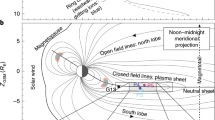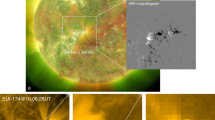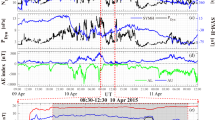Abstract
Magnetic reconnection is a key process that explosively accelerates charged particles, generating phenomena such as nebular flares1, solar flares2 and stunning aurorae3. In planetary magnetospheres, magnetic reconnection has often been identified on the dayside magnetopause and in the nightside magnetodisc, where thin-current-sheet conditions are conducive to reconnection4. The dayside magnetodisc is usually considered thicker than the nightside due to the compression of solar wind, and is therefore not an ideal environment for reconnection. In contrast, a recent statistical study of magnetic flux circulation strongly suggests that magnetic reconnection must occur throughout Saturn’s dayside magnetosphere5. Additionally, the source of energetic plasma can be present in the noon sector of giant planetary magnetospheres6. However, so far, dayside magnetic reconnection has only been identified at the magnetopause. Here, we report direct evidence of near-noon reconnection within Saturn’s magnetodisc using measurements from the Cassini spacecraft. The measured energetic electrons and ions (ranging from tens to hundreds of keV) and the estimated energy flux of ~2.6 mW m–2 within the reconnection region are sufficient to power aurorae. We suggest that dayside magnetodisc reconnection can explain bursty phenomena in the dayside magnetospheres of giant planets, which can potentially advance our understanding of quasi-periodic injections of relativistic electrons6 and auroral pulsations7.
This is a preview of subscription content, access via your institution
Access options
Access Nature and 54 other Nature Portfolio journals
Get Nature+, our best-value online-access subscription
$29.99 / 30 days
cancel any time
Subscribe to this journal
Receive 12 digital issues and online access to articles
$119.00 per year
only $9.92 per issue
Buy this article
- Purchase on Springer Link
- Instant access to full article PDF
Prices may be subject to local taxes which are calculated during checkout



Similar content being viewed by others
References
Clausen-Brown, E. & Lyutikov, M. Crab nebula gamma-ray flares as relativistic reconnection minijets. Mon. Not. R. Astron. Soc. 426, 1374–1384 (2012).
Parker, E. N. The solar-flare phenomenon and the theory of reconnection and annihilation of magnetic fields. Astrophys. J. Suppl. Ser. 8, 177 (1963).
Dungey, J. W. Interplanetary magnetic field and the auroral zones. Phys. Rev. Lett. 6, 47 (1961).
Paschmann, G. et al. Plasma acceleration at the Earth’s magnetopause: evidence for reconnection. Nature 282, 243–246 (1979).
Delamere, P., Otto, A., Ma, X., Bagenal, F. & Wilson, R. Magnetic flux circulation in the rotationally driven giant magnetospheres. J. Geophys. Res. Space Phys. 120, 4229–4245 (2015).
Roussos, E. et al. Quasi-periodic injections of relativistic electrons in Saturn’s outer magnetosphere. Icarus 263, 101–116 (2016).
Mitchell, D. et al. Recurrent pulsations in Saturn’s high latitude magnetosphere. Icarus 263, 94–100 (2016).
Vasyliunas, V. Plasma distribution and flow. Phys. Jovian Magnetos. 1, 395–453 (1983).
Burkholder, B. et al. Local time asymmetry of Saturn’s magnetosheath flows.Geophys. Res. Lett. 44, 5877–5883 2017).
Yao, Z. et al. Corotating magnetic reconnection site in Saturn’s magnetosphere.Astrophys. J. Lett. 846, L25 (2017).
Angelopoulos, V. et al. Tail reconnection triggering substorm onset. Science 321, 931–935 (2008).
Arridge, C. S. et al. Cassini in situ observations of long-duration magnetic reconnection in Saturn’s magnetotail.Nat. Phys. 12, 268–271 2016).
Kronberg, E., Kasahara, S., Krupp, N. & Woch, J. Field-aligned beams and reconnection in the jovian magnetotail. Icarus 217, 55–65 (2012).
Dougherty, M. K. et al. The Cassini magnetic field investigation. Space Sci. Rev. 114, 331–383 (2004).
Young, D. et al. Cassini plasma spectrometer investigation. Space Sci. Rev. 114, 1–112 (2004).
Nagai, T. et al. Geotail observations of the Hall current system: evidence of magnetic reconnection in the magnetotail. J. Geophys. Res. Space Phys. 106, 25929–25949 (2001).
Krimigis, S. M. et al. Magnetosphere imaging instrument (MIMI) on the Cassini mission to Saturn/Titan. Space. Sci. Rev. 114, 233–329 (2004).
Lindstedt, T. et al. Separatrix regions of magnetic reconnection at the magnetopause.Ann. Geophys. 27, 4039–4056 (2009).
Mauk, B. et al. Transient aurora on Jupiter from injections of magnetospheric electrons. Nature 415, 1003 (2002).
Wang, S. et al. Electron heating in the exhaust of magnetic reconnection with negligible guide field. J. Geophys. Res. Space Phys. 121, 2104–2130 (2016).
Birn, J. et al. Geospace environmental modeling (GEM) magnetic reconnection challenge. J. Geophys. Res. Space Phys. 106, 3715–3719 (2001).
Palmaerts, B. et al. Statistical analysis and multi-instrument overview of the quasi-periodic 1-hour pulsations in Saturn’s outer magnetosphere. Icarus 271, 1–18 (2016).
Radioti, A. et al. Auroral signatures of multiple magnetopause reconnection at Saturn. Geophys. Res. Lett. 40, 4498–4502 (2013).
Gérard, J. C. et al. Altitude of Saturn’s aurora and its implications for the characteristic energy of precipitated electrons. Geophys. Res. Lett. 36, L02202 (2009).
Grodent, D., Gérard, J. C., Clarke, J., Gladstone, G. & Waite, J.A possible auroral signature of a magnetotail reconnection process on Jupiter.J. Geophys. Res. Space Phys. 109, A05201 (2004).
Badman, S. V. et al. Bursty magnetic reconnection at Saturn’s magnetopause. Geophys. Res. Lett. 40, 1027–1031 (2013).
Gladstone, G. et al. A pulsating auroral X-ray hot spot on Jupiter. Nature 415, 1000–1003 (2002).
Fu, H. S., Khotyaintsev, Y. V., Vaivads, A., Retino, A. & Andre, M. Energetic electron acceleration by unsteady magnetic reconnection. Nat. Phys. 9, 426–430 (2013).
Kanani, S. J. et al. A new form of Saturn’s magnetopause using a dynamic pressure balance model, based on in situ, multi-instrument Cassini measurements. J. Geophys. Res. Space Phys. 115, A06207 (2010).
Tao, C., Kataoka, R., Fukunishi, H., Takahashi, Y. & Yokoyama, T.Magnetic field variations in the Jovian magnetotail induced by solar wind dynamic pressure enhancements.J. Geophys. Res. 110, A11208 (2005).
Arridge, C. et al. Saturn’s magnetodisc current sheet. J. Geophys. Res. Space Phys. 113, A04214(2008).
Arridge, C. S. et al. Periodic motion of Saturn’s nightside plasma sheet.J. Geophys. Res. Space Phys. 116, A11205 (2011).
Sergeev, V. et al. Current sheet flapping motion and structure observed by Cluster. Geophys. Res. Lett. 30, 1327–1324 (2003).
Runov, A. et al. Electric current and magnetic field geometry in flapping magnetotail current sheets.Ann. Geophys. 23, 1391–1403 (2005).
Delamere, P. A., Wilson, R. J. & Masters, A.Kelvin–Helmholtz instability at Saturn’s magnetopause: hybrid simulations.J. Geophys. Res. Space Phys. 116, A10222 (2011).
Masters, A. et al. Cassini observations of a Kelvin–Helmholtz vortex in Saturn’s outer magnetosphere.J. Geophys. Res. Space Phys. 115, A07225 (2010).
Sweet, P. A. The production of high energy particles in solar flares. Nuovo Cimento 8, 188–196 (1958).
Parker, E. N. Sweet’s mechanism for merging magnetic fields in conducting fluids. J. Geophys. Res. 62, 509–520 (1957).
Thomsen, M. F. et al. Survey of ion plasma parameters in Saturn’s magnetosphere.J. Geophys. Res. Space Phys. 115, A10220 (2010).
Korovinskiy, D. B., Semenov, V. S., Erkaev, N. V., Divin, A. V. & Biernat, H. K. The 2.5-D analytical model of steady-state Hall magnetic reconnection. J. Geophys. Res. Space Phys. 113, A04205 (2008).
Nichols, J. D. et al. Saturn’s equinoctial auroras.Geophys. Res. Lett. 36, L24102 (2009).
Yao, Z. H. et al. Mechanisms of Saturn’s near-noon transient aurora: in situ evidence from Cassini measurements.Geophys. Res. Lett. 44, 217–228 (2017).
Acknowledgements
This work was supported by the National Science Foundation of China (41525016, 41474155, 41704169, 41274167 and 41621063). Z.H.Y. is a Marie Curie COFUND research fellow, cofunded by the EU. Cassini operations are supported by NASA (managed by the Jet Propulsion Laboratory) and European Space Agency (ESA). R.L.G. is supported by the opening fund of the Lunar and Planetary Science Laboratory (a partner laboratory of the Key Laboratory of Lunar and Deep Space Exploration) (Macau FDCT grant 039/2013/A2). I.J.R. is supported in part by Science and Technology Facilities Council (STFC) grant ST/N000722/1. Z.H.Y., B.P. and D.G. are supported by the PRODEX programme managed by ESA in collaboration with the Belgian Federal Science Policy Office. W.R.D. is supported by an STFC research grant to University College London, an SAO fellowship to the Harvard–Smithsonian Centre for Astrophysics and ESA contract 4000120752/17/NL/MH. A.J.C. is supported by STFC Consolidated Grants to UCL-MSSL (ST/K000977/1 and ST/N000722/1).
Author information
Authors and Affiliations
Contributions
All authors were involved in writing the paper. R.L.G., Z.H.Y. and Y.W. led the work and conducted most of the analysis for the Cassini measurements. L.C.R. provided knowledge of planetary magnetospheric dynamics and critical review of the techniques applied, along with extensive paper writing and data analysis. I.J.R., C.S.A., P.A.D., Z.Y.P. and J.L.B. provided expertise on auroral drivers and magnetospheric processes. N.S. and P.K. provided crucial support in using ion data, as well as insight on magnetospheric dynamics. A.J.C., D.G., W.R.D., J.H.W., B.P. and M.K.D. provided detailed knowledge of planetary magnetospheres.
Corresponding author
Additional information
Publisher’s note: Springer Nature remains neutral with regard to jurisdictional claims in published maps and institutional affiliations.
Supplementary information
Supplementary Information
Supplementary Figures 1–6
Rights and permissions
About this article
Cite this article
Guo, R.L., Yao, Z.H., Wei, Y. et al. Rotationally driven magnetic reconnection in Saturn’s dayside. Nat Astron 2, 640–645 (2018). https://doi.org/10.1038/s41550-018-0461-9
Received:
Accepted:
Published:
Issue Date:
DOI: https://doi.org/10.1038/s41550-018-0461-9
This article is cited by
-
Magnetic reconnection in the magnetodisk of centrifugally dominated giant planets
Reviews of Modern Plasma Physics (2024)
-
Missing link found?
Nature Astronomy (2018)



